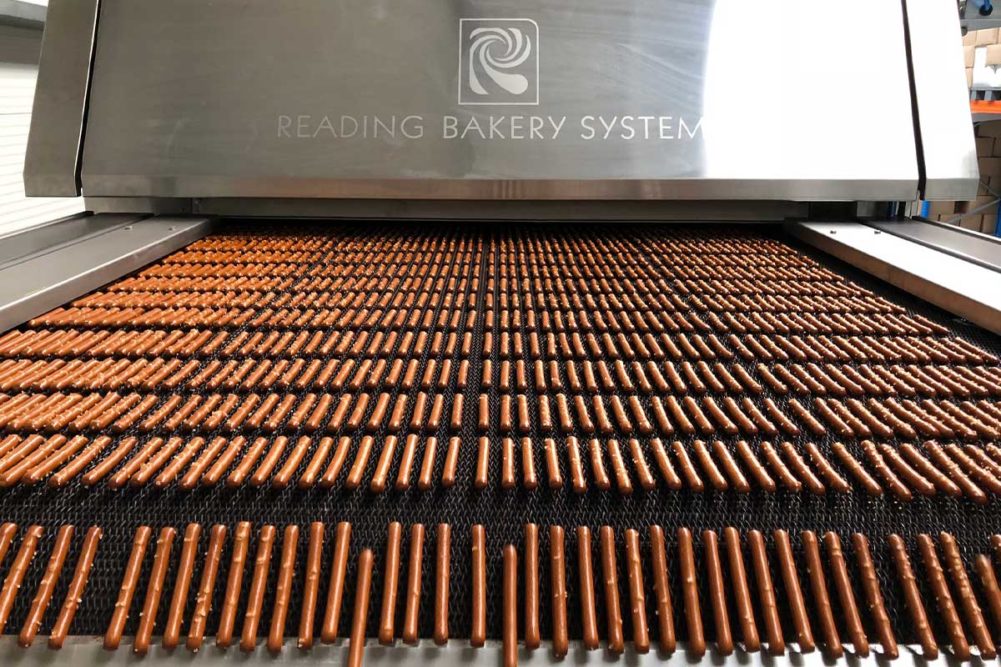The pretzel is the epitome of versatility. Pretzels can be soft or hard, small or large, filled and unfilled. They come in a variety of shapes and forms, which leads to unending possibilities of innovation. To keep up with consumer demand for the latest and greatest in pretzels, processors have their work cut out for them in keeping production nimble.
“We observe among the market a lot of diversity in pretzel shapes: pretzel buns, bites, traditional pretzels, etc.,” said Felix Pang, sales engineer, ABI. “The latest trends influence processing in a number of ways; not the least of these is that the wide variety of different products a bakery might be producing has added a dimension of complexity to automating in general.”
More variety means less uniformity, which doesn’t bode well for automation that thrives on predictability. That leaves pretzel manufacturers looking to incorporate more capabilities and flexibility in their equipment.
As pretzel manufacturers incorporate these products into their production, not only will they impact how they address automation and operations, but each one comes with its own unique challenges and sometimes equipment.
Production efficiency and improved product quality and consistency go hand in hand. But to optimize both production and the finished product, pretzel manufacturers would be wise to automate and not rely on the inconsistency that comes with a hands-on process.
“What’s done with a Fritsch twister versus by hand: The product made by the Fritsch twister all looks the same,” said Matt Zielsdorf, director of sales for Fritsch, a Multivac Group company. “The manufacturer can maintain product quality and consistency. The product is going to be the same weight, so they aren’t giving anything away coming off the production line.”
On Fritsch’s Multitwist, accurate shapes are consistently ensured by a centering device, which checks the length and position of dough strands. These are automatically corrected when necessary, and out-of-spec strands are rejected without the line stopping. While Fritsch doesn’t produce every piece of equipment on a pretzel production line, their systems are designed to integrate with automation. Mr. Zielsdorf recommended pretzel manufacturers be producing 4,000 to 6,000 pieces per hour to automate transfers. While the Multitwist can put out up to 2,000 pieces per hour, the line’s capacity can be increased by connecting several twisting modules to reach capacities of up to 20,000 pretzels per hour.
Minimizing or eliminating waste and improving accuracy are common benefits of automation. John Giacoio, vice president of sales, Rheon USA, pointed out that coextrusion for filled soft pretzels virtually eliminates waste and any excess trim that needs to be reworked back into the dough.
“The Rheon co-extruders are extremely accurate machines when forming filled products,” he said. “The key to a consistent product is maintaining the environment and consistency of the materials being placed into the machine.”
A uniform dough is key to ensuring the most consistent quality throughout every shift, whether working with soft or hard pretzels, sheeting or extrusion.
“If the dough is the same throughout a run, operators do not need to constantly adjust bake times or temperatures to make up for the different moisture levels in the dough,” said Nico Roesler, North American pretzel and snack equipment sales manager, Reading Bakery Systems (RBS). “Some challenges are more difficult to manage, like the changing quality in wheat flour. If a wheat supply changes drastically in its protein content, it can change the product. So managing ingredient sourcing and keeping an eye on any changes to dough processing or baking is critical.”
The other aspect of production efficiency involves reducing changeovers and the time it takes to execute them. The RBS low-pressure extruder, for example, can switch between pretzel products by exchanging the compression head and die plates.
“That together with the automated control settings that are recipe-driven allows bakers to take the guesswork out of product changeovers,” Mr. Roesler explained.
Whether tackling pretzel buns, bites, filled pretzels or new shapes, however, can require new equipment or components to integrate into a line. And each type of product comes with its own challenges to solve.
This article is an excerpt from the October 2023 issue of Baking & Snack. To read the entire feature on Pretzel Processing, click here.






